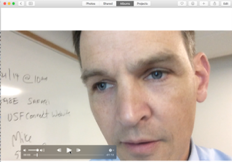Monthly Archives: January 2017
Video of the Day: 1989 Tour de Trump
For class Tuesday 1/31/2017

Hi everyone,
There are four asks for class on Tuesday. I expect that these tasks will take less than 1.5 hours to complete.
1. Please post to your blog your thoughts about Strickland’s article “What Every Kid Wants” — you can use what you wrote in class (10 minutes).
2. Read Tseng & Fogg’s essay on “Credibility and Computing Technology.” This article lays out some key concepts we will use throughout the semester. (25 minutes)
3. Refer to this page of resources: Module 1 Readings & Resources. Rather than choosing one text (as I said in class), please spend about 45 minutes (or more, if you like) with different texts (short articles, scholarly articles, videos). In other words, you can choose 1 or several, but plan to spend about 45 minutes total (or more) in reading & viewing. (45 minutes)
4. Post to your blog about what your read. The post can be informal — you can approach it the way you approach in-class writing (set a timer for 10 minutes and write like crazy). Of course, some people like to write really long blog posts. But that’s a real art form (or mania).
V1: Introduce yourself
V1: My Public Speaking Career (so far)

Speaking of Bicycles
COMS 195-01 | Spring 2017 | Jonathan Hunt
due Thursday January 26, 2017
You’ll make a short video introducing yourself to the class, with specific reference to yourself as a public speaker. You should refer to the material in “Becoming a Public Speaker.”
Your video should be less than 1 minute long.
The Purpose
This assignment has two main goals:
- practice, practice, practice
Success in public speaking takes practice. Many people avoid practicing because they have fear or anxiety about public speaking. Making videos is a great way to practice without having to bring together a live audience!
2. self-assessment and reflection
Talking about your own knowledge and experience can help you develop more accurate self-assessments. If you aware of and understand your own strengths and weaknesses, you will be able to plan and prepare your speeches more effectively.
Instructions
In class, you wrote about your experiences with public speaking and your ideas about how to be successful as a speaker.
Think about what you wrote in class, and about what other students said in discussion. Using these ideas, write a few notes for yourself. You should try to focus on only a few key ideas or examples.
Use your phone or computer to record a short video introducing yourself to the class. Be sure to include key information (most importantly, your name and what you would like people to call you).
Make several different versions and choose the one you like best.
Remember, your video should be less than 60 seconds long.
Assignment Checklist
Short video, less than 60 seconds.
Introduce yourself to the class—be sure to include your name.
Tell a little about yourself as a public speaker: what are your experiences, your strengths, your challenges?
Or talk about bicycles.
Bring the video (on your phone or computer) to class on Thursday, January 26 — or, if you are able to get your blog up and running, post it there.
Becoming a Public Speaker
The first chapter of A Pocket Guide to Public Speaking offers some great observations about the work we’ll do in this course.
First, the authors emphasize that public speaking is a valuable skill that applies to your other courses and to your whole life.
Second, they point out that communication is essential for citizenship: in a democracy, effective communicators have the opportunity to shape law and policy.
Finally, they give some tips for how to draw on your prior knowledge and experience to succeed in this course.
Access the text via Canvas:
Strickland’s “What Every Kid Wants”
Bill Strickland’s essay, “What Every Kid Wants,” is a nostalgia-soaked meditation on the role of bicycles in American childhood.
Read Strickland’s essay (available via Canvas) for Thursday, January 25th.
You can read more of Strickland’s work at Bicycling magazine.
Why I’ll Never Ride a Bike in New York City
It’s humor.
“I crash into things when I’m walking on the sidewalk.”
http://www.newyorker.com/humor/daily-shouts/why-ill-never-ride-a-bike-in-new-york-city
Supes Affirm Support for Ghost Bikes
Allowing makeshift memorials dubbed “ghost bikes” to remain at the sites of fatal bicycle crashes in San Francisco received unanimous support Tuesday from the Board of Supervisors.
Read more in the SF Examiner:
